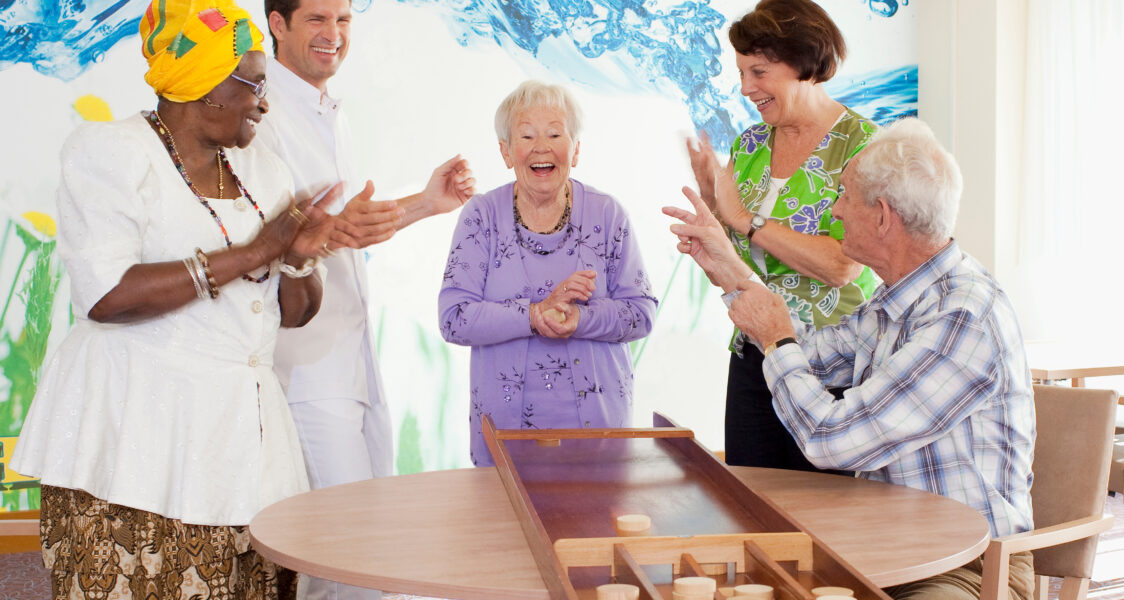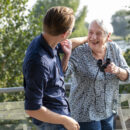Debunking 9 Common Myths about Assisted Living
Misconceptions about assisted living can make an important decision feel overwhelming. Families often picture outdated care settings or worry that a move means losing freedom and connection. In reality, modern assisted living is built to enhance independence, safety, and joy. This guide clears up common myths, shows what life in a community truly looks like, and helps families move forward with confidence as they consider the next chapter for their loved one.

Too often, the process of choosing a senior living community is clouded by misinformation, fear, or outdated stereotypes. Families hear stories about “nursing homes” of the past and assume today’s communities are the same. Others may believe assisted living is only for the very ill or that moving means giving up independence.
The truth is very different. Modern assisted living communities are designed to enhance life, not diminish it. They’re built for safety, dignity, and enjoyment, treating residents like the ladies and gentlemen they are. Let’s separate fact from fiction and debunk the most common myths about assisted living.
Myth 1: “Senior Living Feels Like a Nursing Home”
Many approach senior living tentatively, expecting emotionally distant treatment and sterile, uninviting facilities. The reality of senior living, however, couldn’t be more different. Modern assisted living communities are nothing like the institutional models of the past.
Unlike skilled nursing centers that focus on hospital-level care, today’s assisted living communities emphasize hospitality, home-like comfort, and personal choice. Residents live in private apartments, enjoy restaurant-style dining, and spend their days engaging in social opportunities and meaningful activities.
Myth 2: “It Comes with a Loss of Independence”
Some seniors fear that their freedom will be taken away when they move to assisted living, but communities nowadays work hard to ensure that this fear is far from true. Assisted living is built on independence; support is available only when needed. In reality, assisted living residents enjoy autonomy over their routines, dining preferences, and daily schedules. Staff are available for help with activities of daily living such as bathing, dressing, or medication management, but only as needed.
Myth 3: “Assisted Living Is Only for People with Severe Health Issues”
Many assume that assisted living is meant only for the heavily impaired, but in actuality, assisted living supports a wide range of needs. Often, this care takes place long before serious challenges arise. In fact, many residents move in while still active, choosing the community lifestyle for convenience, safety, and enrichment. Early transitions often allow for smoother adjustments and a better quality of life. When higher levels of care are needed, services adapt to meet residents where they are, which cuts out the need for stressful crisis-driven moves.
Myth 4: “Residents Have to Give Up Interests and Hobbies”
This concern is unfounded. No good place of residence, whether it be an apartment or a neighborhood, should determine what you can and cannot be interested in. Senior living is no different.
Assisted living communities encourage preexisting passions and help residents discover new ones. Far from limiting engagement, communities offer abundant opportunities for recreation, learning, and connection. From gardening and fitness classes to book clubs and art studios, residents continue pursuing what they love while exploring fresh experiences.
Myth 5: “Residents are Lonely”
Isolation is one of the greatest challenges for older adults living at home, which is why assisted living offers built-in companionship through shared meals, group activities, and spontaneous conversations with neighbors. It’s in the name. Assisted living communities are a great place to connect with people of similar interests and foster lasting friendships. In fact, community living actually reduces loneliness.
Structured social opportunities are intentionally designed to foster belonging. Staff encourage meaningful relationships, ensuring each family member feels seen, known, and valued.
Myth 6: “Care Will Be Cold and Impersonal”
When you choose the right community, the opposite is true. Quality care is compassionate, personal, and respectful. At Koelsch, we believe in “ladies and gentlemen serving ladies and gentlemen.” Care is not one-size-fits-all; it’s tailored to each resident’s needs, preferences, and personality. Personal care plans ensure attention to detail, while staff treat every individual with warmth and respect. Families gain peace of mind knowing their loved one is cared for with dignity.
Myth 7: “Seniors Will Lose Control over Their Lives”
Residents actually have choice and control in every aspect of daily living. From dining options to activity participation, assisted living empowers residents to live life their way. Communities provide safety nets, not restrictions. Flexibility is built into the lifestyle, allowing each resident to shape their own experience.
Myth 8: “It’s Safer to Stay at Home”
Many families believe remaining at home is the safest option. However, in a lot of cases, it’s safer in an assisted living community. Senior living often provides greater safety and security than aging in place, while aging homes can pose risks like stairs, slippery bathrooms, and delayed medical response. Assisted living provides:
- 24/7 staff availability
- Emergency call systems
- Built-in safety features
- Access to health support before issues become crises
Myth 9: “Families Will Be Less Involved After a Move”
This is dependent on the family. If caretakers wish to take a step back after the move or their loved ones wish to be more independent, then some separation can happen. However, what assisted living communities do not do is force families apart.
A move to assisted living does not diminish family involvement. On the contrary, it can strengthen relationships by allowing families to focus on quality time rather than daily caregiving tasks. Families remain vital partners in care and community life. Loved ones are also welcome to participate in events, meals, and special moments.
Is Assisted Living Right for Your Parent?
If your loved one struggles with daily tasks, feels isolated, or needs help with personal care, it may be time to consider assisted living. Touring a community and talking with staff is often the best way to determine fit.
Closing Thoughts
Making decisions about senior living is never easy, especially with so much misinformation. Yet when you look beyond the myths, you’ll discover communities filled with joy, safety, and opportunity. Assisted living is not the end of independence; it’s often the beginning of a fuller, more connected chapter of life.
The Koelsch Difference
For more than 60 years, Koelsch Communities has been family-owned and trusted to provide “Mom-approved” care. Our mission is to create happiness by offering the finest living experiences anywhere, grounded in dignity, respect, and compassion.
We offer independent living, assisted living, and memory care, each designed to foster connection, joy, and purpose. At Koelsch, we honor our residents as Ladies and Gentlemen, ensuring they receive the thoughtful attention and personalized support they deserve.
If you are considering senior living for yourself or a loved one, we invite you to experience the Koelsch difference and discover why families across the country have placed their trust in our care since 1958.
Disclaimer: This article is for informational purposes only and does not constitute medical, legal, or financial advice. Please consult with a qualified professional for guidance related to your specific situation.









